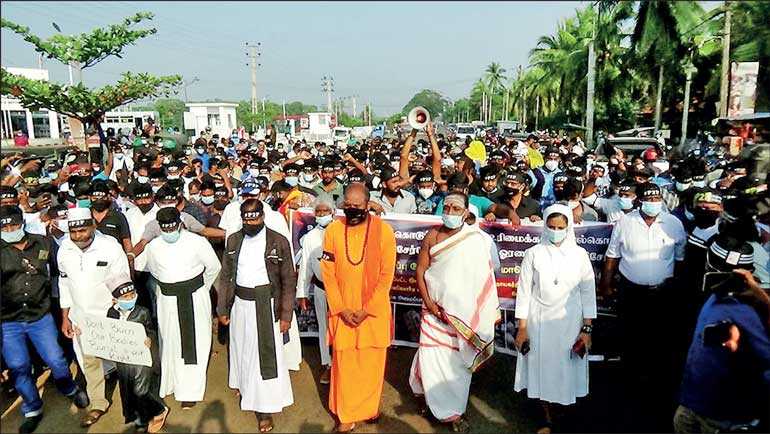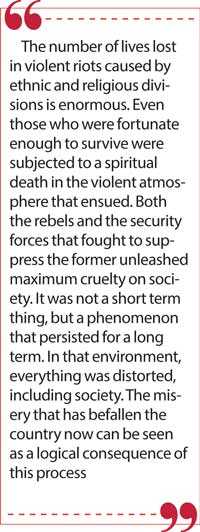Thursday Apr 24, 2025
Thursday Apr 24, 2025
Friday, 19 February 2021 00:10 - - {{hitsCtrl.values.hits}}

The ‘Pothuvil to Polikandy’ or ‘P2P protest by Tamil-speaking people
 Looking at the recent developments, the Tamil community in the north, which has remained more or less in a state of spiritual demise over a long period, seems to be making a determined effort to breathe freely again.
Looking at the recent developments, the Tamil community in the north, which has remained more or less in a state of spiritual demise over a long period, seems to be making a determined effort to breathe freely again.
Not only the Tamil community but also the Sinhala and Muslim communities were in a similar state. In other words, their social psyche has been lying in a state of infirmity for a long time. It is also an important factor contributing to the current deplorable situation in the country.
The social psyche of Sinhala, Tamil and Muslim communities, which has become distorted or partly paralysed, can be revived and restored, at least to a certain extent, only through concerted efforts to breathe freely.
The number of lives lost in violent riots caused by ethnic and religious divisions is enormous. Even those who were fortunate enough to survive were subjected to a spiritual death in the violent atmosphere that ensued.
Both the rebels and the security forces that fought to suppress the former unleashed maximum cruelty on society. It was not a short term thing, but a phenomenon that persisted for a long term. In that environment, everything was distorted, including society. The misery that has befallen the country now can be seen as a logical consequence of this process.
The two Sinhala youth insurrections
Violent insurrections first erupted not in the Tamil north but in the Sinhala south. Both of them can be considered as riots led by Wijeweera’s JVP. The scale of the ’71 insurrection was not as big as that of the second insurrection that broke out in ’87-’89.
Ninety-five percent of the leaders of the first uprising were fortunate enough to survive, while not even 5% of the leaders of the second uprising were spared. The total number killed in the first uprising was less than 5,000; the total number killed in the second uprising was more than 5,000.
Not only rebels, even the security forces unleashed maximum atrocities on society. It is clear that the element of caste, rather than race or ethnicity, played an important role in the two riots.
A discernible characteristic inherent in these two insurrections had been that the rebels did not explain their aspirations directly, except indirectly manifesting some aspects of them. Although they appeared for a kind of socialism, they did not express their grievances genuinely.
The second insurrection of JVP can be considered a brutal uprising and it was also suppressed in a most brutal manner. Most of the leaders arrested, including Wijeweera, were exterminated arbitrarily.
Following the suppression of the insurgency, President Premadasa appointed a Presidential Commission to probe into the causes of the youth uprising, but the recommendations made by the commission were not implemented. During the reign of President Chandrika, a system was introduced to explore into the missing persons and pay compensation, but a formal inquiry was not held.
However, the right to commemorate the rebels who lost their lives in the course of the insurrection was not denied. There was also no barring of the sympathisers of the political legacy of the JVP in entering into the democratic stream of politics.
Tamil rebellion
The Tamil uprising steered by Prabhakaran was capable of being held onto for a long and consecutive period of 25 years. It can also be considered as an extremely cruel rebellion; it was defeated in an equally cruel manner.
The extent of damage caused particularly to the Tamil people in the north and east and the people of Sri Lanka in general, by Prabhakaran’s Eelam War and the anti-Eelam war launched by the Government of Sri Lankan against the rebels was immense.
While the total number of lives lost could be more than 100,000, the damage to property was enormous. A large number of people have been maimed; and the number of widows who have lost their husbands is estimated to be around 80,000. There are allegations of massive human rights abuses at the final stage of the war.
More than 11 years have lapsed since the ending of the internal Civil War. Yet, so far it has not been able to investigate into the loss of life, property and human rights abuses and implement a reforms program acceptable to the affected people, and to bring their lives back to normal.
There is a substantial number of suspects being held in pre-trial detention indefinitely. A large extent of land acquired by the security forces during the war has not been returned in full, except a certain portion of it.
The ugliest thing is the denial of the right of the family members to commemorate their loved ones who were killed during the rebellion. The total death toll of Prabhakaran’s rebellion and the counter war can be almost double the total number killed in the second JVP uprising. Both race or ethnicity and caste seem to have influenced the rebellion initiated by Prabhakaran.
Failure to build the nation
In the sphere of ethnic, religious and caste issues, Sri Lanka can be considered as a country that has gone astray since independence. The refusal to recognise the small groups of citizens who fall into the category of ‘minorities’ in terms of their ethnicity, religion and caste as deserving equal rights and equal human dignity can be considered the biggest factor that has led to the failure of the country. There was no nation building in Sri Lanka as the independence received was more of a gift from the British than an outcome of an independent struggle.
Further the Sinhala, Tamil and Muslim leaders lacked the theoretical understanding of the concept of nation building and its importance. So much so, the Sinhala leaders were influenced by the ideology of Anagarika Daramapala who tended to disparage all non-Sinhala Buddhists and treat them as pariahs or social outcasts.
The Burghers were the first to be classified as “pariahs”. Both Sinhala and Tamil communities tended to look down upon the Burghers. They used to call them as “Karapotu Lansi” (“Cockroach Lansi”) or “Thuppahi Lansi”.
look down upon the Burghers. They used to call them as “Karapotu Lansi” (“Cockroach Lansi”) or “Thuppahi Lansi”.
The Burghers, realising in advance that they had no future in independent Sri Lanka, began to leave Sri Lanka in large numbers following independence. At that time, Sinhalese and Tamils were more concerned with the taking over of the positions held by the Burghers in the public service.
In the communal sense, the next horrific attack was on plantation workers of Indian origin. At the first Parliamentary Election, the plantation workers voted for the LSSP candidates in electorates which were not contested by the Indian Congress.
Prime Minister D.S. Senanayake, who had not received a clear majority to form a government on his own strength, was angry when the seven members elected on behalf of plantation workers refused to support him in forming a government.
Apparently, this led Prime Minister D.S. Senanayake to enact citizenship laws in such a way that even those who were entitled to citizenship would find it difficult in securing their rights.
It can be considered as the first major human rights violation committed even before the ink of the Soulbury Constitution had run dry. Strangely, in that case, all Tamil MPs representing the north and east, except Chelvanayagam and one other MP, supported the passage of the law which deprived the plantation workers of their civic rights.
Tamil struggle assuming a violent path
The Sinhala Official Language Act, enacted by Bandaranaike in 1956 depriving the Tamil people of their language rights, which cannot be justified by any means, can be considered as the next terrible blow in the field of ethnicity.
Restoring the recognition of vernacular languages was an indispensable necessity, but it should have been done in a manner that would not have deprived the Tamil people of their linguistic rights and destroyed the bilingual education.
So much so, the language policy of Bandaranaike led to generate confusion in the bilingual policy and deprived the Tamil people of their language rights, and in consequence the country was plunged into a big mess that could not be resolved easily.
The policy adopted by the Muslim leaders regarding the Sinhala Official Language policy, it should be said, was opportunistic and selfish. Instead of appearing for a just policy acceptable to all concerned, Muslims also endorsed the Sinhala Only policy.
Tamil leaders have waged a fierce struggle within a nonviolent and democratic framework for nearly 20 years to secure the language rights of their people. But the Sinhala extremist forces did not allow making any just change in this respect.
The dialogue ensued in this connection did not lead to weaken the attitude of Sinhala extremism, but to strengthen it. The immense damage wrought by the ’83 Black July on Tamil people led to push the peaceful Tamil struggle into a movement of violence. The tense environment that ensued resulted in the democratic leaders of the Tamil community losing their recognition and conferring a greater acceptance to militant leaders like Prabhakaran.
After defeating Prabhakaran and the Eelam war, the Sinhala extremists wanted to replace the Tamil with a new enemy. For that they found Muslims as their new perceived enemy. The story of the alleged use of sterilisation medicine and methods secretly to reduce the growth of the Sinhala population is arguably the most powerful and terrifying weapon employed for this purpose. The anti-Muslim program of the Sinhala extremist forces seems to have inspired the Tamil people as well, in the early days of its development.
Historically, the Sinhala extremist forces are in a complete crisis, incapable of being rescued. By now, they have taken Sri Lanka not to a Ketumathi kingdom, but to a fiery hell.
Even the Sinhala Buddhist forces that were used to listen to those extremist forces with confidence have begun to realise that.
This situation, of course, will provide a solid foundation for Sri Lanka to build the modern nation as well as to win the structural reforms it badly needs. To achieve this, not only the Tamil people in the north but also the Sinhala, Muslim and the Up-country Tamils should take the initiative and strive to breathe freely. Only then will their spirit, which has partially atrophied, be revived and restored.
Discover Kapruka, the leading online shopping platform in Sri Lanka, where you can conveniently send Gifts and Flowers to your loved ones for any event including Valentine ’s Day. Explore a wide range of popular Shopping Categories on Kapruka, including Toys, Groceries, Electronics, Birthday Cakes, Fruits, Chocolates, Flower Bouquets, Clothing, Watches, Lingerie, Gift Sets and Jewellery. Also if you’re interested in selling with Kapruka, Partner Central by Kapruka is the best solution to start with. Moreover, through Kapruka Global Shop, you can also enjoy the convenience of purchasing products from renowned platforms like Amazon and eBay and have them delivered to Sri Lanka.
Discover Kapruka, the leading online shopping platform in Sri Lanka, where you can conveniently send Gifts and Flowers to your loved ones for any event including Valentine ’s Day. Explore a wide range of popular Shopping Categories on Kapruka, including Toys, Groceries, Electronics, Birthday Cakes, Fruits, Chocolates, Flower Bouquets, Clothing, Watches, Lingerie, Gift Sets and Jewellery. Also if you’re interested in selling with Kapruka, Partner Central by Kapruka is the best solution to start with. Moreover, through Kapruka Global Shop, you can also enjoy the convenience of purchasing products from renowned platforms like Amazon and eBay and have them delivered to Sri Lanka.